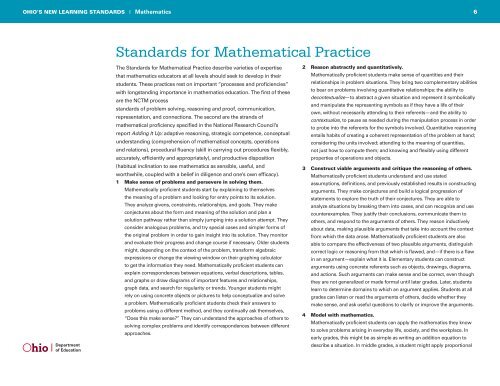Math-Standards.pdf
Math-Standards.pdf
Math-Standards.pdf
You also want an ePaper? Increase the reach of your titles
YUMPU automatically turns print PDFs into web optimized ePapers that Google loves.
OHIO’S NEW LEARNING STANDARDS I <strong>Math</strong>ematics 6<br />
<strong>Standards</strong> for <strong>Math</strong>ematical Practice<br />
The <strong>Standards</strong> for <strong>Math</strong>ematical Practice describe varieties of expertise<br />
that mathematics educators at all levels should seek to develop in their<br />
students. These practices rest on important “processes and proficiencies”<br />
with longstanding importance in mathematics education. The first of these<br />
are the NCTM process<br />
standards of problem solving, reasoning and proof, communication,<br />
representation, and connections. The second are the strands of<br />
mathematical proficiency specified in the National Research Council’s<br />
report Adding It Up: adaptive reasoning, strategic competence, conceptual<br />
understanding (comprehension of mathematical concepts, operations<br />
and relations), procedural fluency (skill in carrying out procedures flexibly,<br />
accurately, efficiently and appropriately), and productive disposition<br />
(habitual inclination to see mathematics as sensible, useful, and<br />
worthwhile, coupled with a belief in diligence and one’s own efficacy).<br />
1 Make sense of problems and persevere in solving them.<br />
<strong>Math</strong>ematically proficient students start by explaining to themselves<br />
the meaning of a problem and looking for entry points to its solution.<br />
They analyze givens, constraints, relationships, and goals. They make<br />
conjectures about the form and meaning of the solution and plan a<br />
solution pathway rather than simply jumping into a solution attempt. They<br />
consider analogous problems, and try special cases and simpler forms of<br />
the original problem in order to gain insight into its solution. They monitor<br />
and evaluate their progress and change course if necessary. Older students<br />
might, depending on the context of the problem, transform algebraic<br />
expressions or change the viewing window on their graphing calculator<br />
to get the information they need. <strong>Math</strong>ematically proficient students can<br />
explain correspondences between equations, verbal descriptions, tables,<br />
and graphs or draw diagrams of important features and relationships,<br />
graph data, and search for regularity or trends. Younger students might<br />
rely on using concrete objects or pictures to help conceptualize and solve<br />
a problem. <strong>Math</strong>ematically proficient students check their answers to<br />
problems using a different method, and they continually ask themselves,<br />
“Does this make sense?” They can understand the approaches of others to<br />
solving complex problems and identify correspondences between different<br />
approaches.<br />
2 Reason abstractly and quantitatively.<br />
<strong>Math</strong>ematically proficient students make sense of quantities and their<br />
relationships in problem situations. They bring two complementary abilities<br />
to bear on problems involving quantitative relationships: the ability to<br />
decontextualize—to abstract a given situation and represent it symbolically<br />
and manipulate the representing symbols as if they have a life of their<br />
own, without necessarily attending to their referents—and the ability to<br />
contextualize, to pause as needed during the manipulation process in order<br />
to probe into the referents for the symbols involved. Quantitative reasoning<br />
entails habits of creating a coherent representation of the problem at hand;<br />
considering the units involved; attending to the meaning of quantities,<br />
not just how to compute them; and knowing and flexibly using different<br />
properties of operations and objects.<br />
3 Construct viable arguments and critique the reasoning of others.<br />
<strong>Math</strong>ematically proficient students understand and use stated<br />
assumptions, definitions, and previously established results in constructing<br />
arguments. They make conjectures and build a logical progression of<br />
statements to explore the truth of their conjectures. They are able to<br />
analyze situations by breaking them into cases, and can recognize and use<br />
counterexamples. They justify their conclusions, communicate them to<br />
others, and respond to the arguments of others. They reason inductively<br />
about data, making plausible arguments that take into account the context<br />
from which the data arose. <strong>Math</strong>ematically proficient students are also<br />
able to compare the effectiveness of two plausible arguments, distinguish<br />
correct logic or reasoning from that which is flawed, and—if there is a flaw<br />
in an argument—explain what it is. Elementary students can construct<br />
arguments using concrete referents such as objects, drawings, diagrams,<br />
and actions. Such arguments can make sense and be correct, even though<br />
they are not generalized or made formal until later grades. Later, students<br />
learn to determine domains to which an argument applies. Students at all<br />
grades can listen or read the arguments of others, decide whether they<br />
make sense, and ask useful questions to clarify or improve the arguments.<br />
4 Model with mathematics.<br />
<strong>Math</strong>ematically proficient students can apply the mathematics they know<br />
to solve problems arising in everyday life, society, and the workplace. In<br />
early grades, this might be as simple as writing an addition equation to<br />
describe a situation. In middle grades, a student might apply proportional


